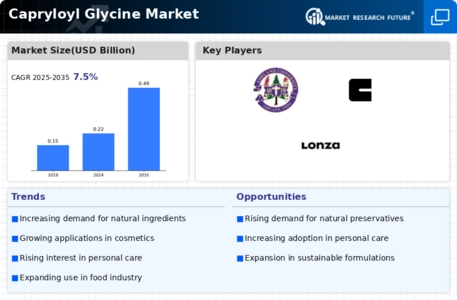Growth of the Personal Care Sector
The Capryloyl Glycine Market is benefiting from the overall growth of the personal care sector. As consumers increasingly prioritize personal grooming and hygiene, the demand for high-quality personal care products is on the rise. Capryloyl glycine, recognized for its multifunctional properties, is being integrated into a variety of personal care items, including shampoos, conditioners, and body washes. Recent market data indicates that the personal care market is projected to expand at a rate of approximately 4.8% per year. This growth is likely to create new opportunities for capryloyl glycine, as manufacturers seek to enhance product efficacy and appeal to health-conscious consumers, thereby driving the Capryloyl Glycine Market.
Innovation in Cosmetic Formulations
The Capryloyl Glycine Market is witnessing a wave of innovation in cosmetic formulations. As brands strive to differentiate themselves in a competitive landscape, there is a growing emphasis on developing unique and effective products. Capryloyl glycine, with its ability to act as a skin-conditioning agent and its compatibility with various formulations, is increasingly being utilized in innovative cosmetic products. This trend is supported by Market Research Future indicating that the cosmetic industry is expected to grow at a compound annual growth rate of around 5% over the next several years. Consequently, the incorporation of capryloyl glycine into new and existing products is likely to enhance its market presence and drive growth within the Capryloyl Glycine Market.
Rising Demand for Anti-Aging Products
The Capryloyl Glycine Market is significantly influenced by the rising demand for anti-aging products. As the global population ages, there is an increasing focus on maintaining youthful skin, leading to a surge in the development of products that promise anti-aging benefits. Capryloyl glycine, with its ability to improve skin texture and elasticity, is becoming a preferred ingredient in these formulations. Market analysis suggests that the anti-aging segment is expected to witness a growth rate of around 6% annually, further propelling the demand for capryloyl glycine. This trend indicates that manufacturers are likely to invest in research and development to create innovative products that leverage the benefits of capryloyl glycine, thus enhancing its presence in the Capryloyl Glycine Market.
Increasing Consumer Awareness of Skin Care
The Capryloyl Glycine Market is experiencing a notable surge in consumer awareness regarding skin care products. As individuals become more informed about the ingredients in their cosmetics, there is a growing preference for formulations that include natural and effective components. Capryloyl glycine, known for its antimicrobial properties and ability to enhance skin hydration, is increasingly sought after. This trend is reflected in market data, which indicates that the skin care segment is projected to grow at a compound annual growth rate of approximately 5.5% over the next five years. Consequently, manufacturers are incorporating capryloyl glycine into their products to meet consumer demands, thereby driving growth in the Capryloyl Glycine Market.
Sustainability Trends in Ingredient Sourcing
The Capryloyl Glycine Market is also influenced by the growing emphasis on sustainability in ingredient sourcing. As consumers become more environmentally conscious, there is a rising demand for sustainably sourced ingredients in personal care and cosmetic products. Capryloyl glycine, often derived from natural sources, aligns well with this trend, making it an attractive option for manufacturers looking to enhance their sustainability credentials. Market data suggests that the demand for sustainable ingredients is expected to increase by approximately 7% annually. This shift towards sustainability is likely to encourage more companies to incorporate capryloyl glycine into their formulations, thereby driving growth in the Capryloyl Glycine Market.

















Leave a Comment